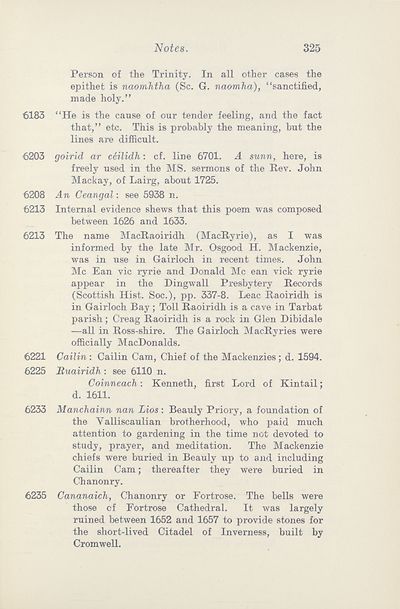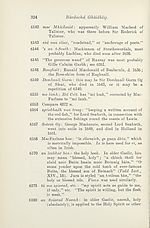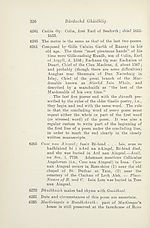Download files
Complete book:
Individual page:
Thumbnail gallery: Grid view | List view

Notes.
325
Person of the Trinity. In all other cases the
epithet is naomhtha (Sc. G. naomha), “sanctified,
made holy.”
6183 “He is the cause of our tender feeling, and the fact
that,” etc. This is probably the meaning, but the
lines are difficult.
6203 goirid ar ciilidh: cf. line 6701. A sunn, here, is
freely used in the MS. sermons of the Rev. John
Mackay, of Lairg, about 1725.
6208 An Ceangal: see 5938 n.
6213 Internal evidence shews that this poem was composed
between 1626 and 1633.
6213 The name MacRaoiridh (MacRyrie), as I was
informed by the late Mr. Osgood H. Mackenzie,
was in use in Gairloch in recent times. John
Me Ban vie ryrie and Donald Me ean vick ryrie
appear in the Dingwall Presbytery Records
(Scottish Hist. Soc.), pp. 337-8. Leac Raoiridh is
in Gairloch Bay ; Toll Raoiridh is a cave in Tarbat
parish; Creag Raoiridh is a rock in Glen Dibidale
—all in Ross-shire. The Gairloch MacRyries were
officially MacDonalds.
6221 Cailin : Cailin Cam, Chief of the Mackenzies; d. 1594.
6225 Buairidh : see 6110 n.
Coinneach: Kenneth, first Lord of Kintail;
d. 1611.
6233 Manchainn nan Lios: Beauly Priory, a foundation of
the Valliscaulian brotherhood, who paid much
attention to gardening in the time not devoted to
study, prayer, and meditation. The Mackenzie
chiefs were buried in Beauly up to and including
Cailin Cam; thereafter they were buried in
Chanonry.
6235 Cananaich, Chanonry or Fortrose. The bells were
those cf Fortrose Cathedral. It was largely
ruined between 1652 and 1657 to provide stones for
the short-lived Citadel of Inverness, built by
Cromwell.
325
Person of the Trinity. In all other cases the
epithet is naomhtha (Sc. G. naomha), “sanctified,
made holy.”
6183 “He is the cause of our tender feeling, and the fact
that,” etc. This is probably the meaning, but the
lines are difficult.
6203 goirid ar ciilidh: cf. line 6701. A sunn, here, is
freely used in the MS. sermons of the Rev. John
Mackay, of Lairg, about 1725.
6208 An Ceangal: see 5938 n.
6213 Internal evidence shews that this poem was composed
between 1626 and 1633.
6213 The name MacRaoiridh (MacRyrie), as I was
informed by the late Mr. Osgood H. Mackenzie,
was in use in Gairloch in recent times. John
Me Ban vie ryrie and Donald Me ean vick ryrie
appear in the Dingwall Presbytery Records
(Scottish Hist. Soc.), pp. 337-8. Leac Raoiridh is
in Gairloch Bay ; Toll Raoiridh is a cave in Tarbat
parish; Creag Raoiridh is a rock in Glen Dibidale
—all in Ross-shire. The Gairloch MacRyries were
officially MacDonalds.
6221 Cailin : Cailin Cam, Chief of the Mackenzies; d. 1594.
6225 Buairidh : see 6110 n.
Coinneach: Kenneth, first Lord of Kintail;
d. 1611.
6233 Manchainn nan Lios: Beauly Priory, a foundation of
the Valliscaulian brotherhood, who paid much
attention to gardening in the time not devoted to
study, prayer, and meditation. The Mackenzie
chiefs were buried in Beauly up to and including
Cailin Cam; thereafter they were buried in
Chanonry.
6235 Cananaich, Chanonry or Fortrose. The bells were
those cf Fortrose Cathedral. It was largely
ruined between 1652 and 1657 to provide stones for
the short-lived Citadel of Inverness, built by
Cromwell.
Set display mode to:
![]() Universal Viewer |
Universal Viewer | ![]() Mirador |
Large image | Transcription
Mirador |
Large image | Transcription
| An Comunn Gàidhealach > An Comunn Gàidhealach Publications > Bardachd Ghaidhlig > (393) |
|---|
| Permanent URL | https://digital.nls.uk/126285848 |
|---|
| Description | This contains items published by An Comunn, which are not specifically Mòd-related. It includes journals, annual reports and corporate documents, policy statements, educational resources and published plays and literature. It is arranged alphabetically by title. |
|---|
| Description | A collection of over 400 items published by An Comunn Gàidhealach, the organisation which promotes Gaelic language and culture and organises the Royal National Mòd. Dating from 1891 up to the present day, the collection includes journals and newspapers, annual reports, educational materials, national Mòd programmes, published Mòd literature and music. |
|---|---|
| Additional NLS resources: |
|

